Understanding and Improving Epilepsy Awareness and Safety
VerifiedAdded on 2020/07/22
|7
|3185
|67
AI Summary
The assignment discusses the importance of understanding and improving epilepsy awareness and safety, particularly in African communities where knowledge about the condition is limited. It emphasizes the need for education and public announcements to change perceptions and improve safety for individuals with epilepsy.
Contribute Materials
Your contribution can guide someone’s learning journey. Share your
documents today.

New Order
1x Practice Based
1x Practice Based
Secure Best Marks with AI Grader
Need help grading? Try our AI Grader for instant feedback on your assignments.
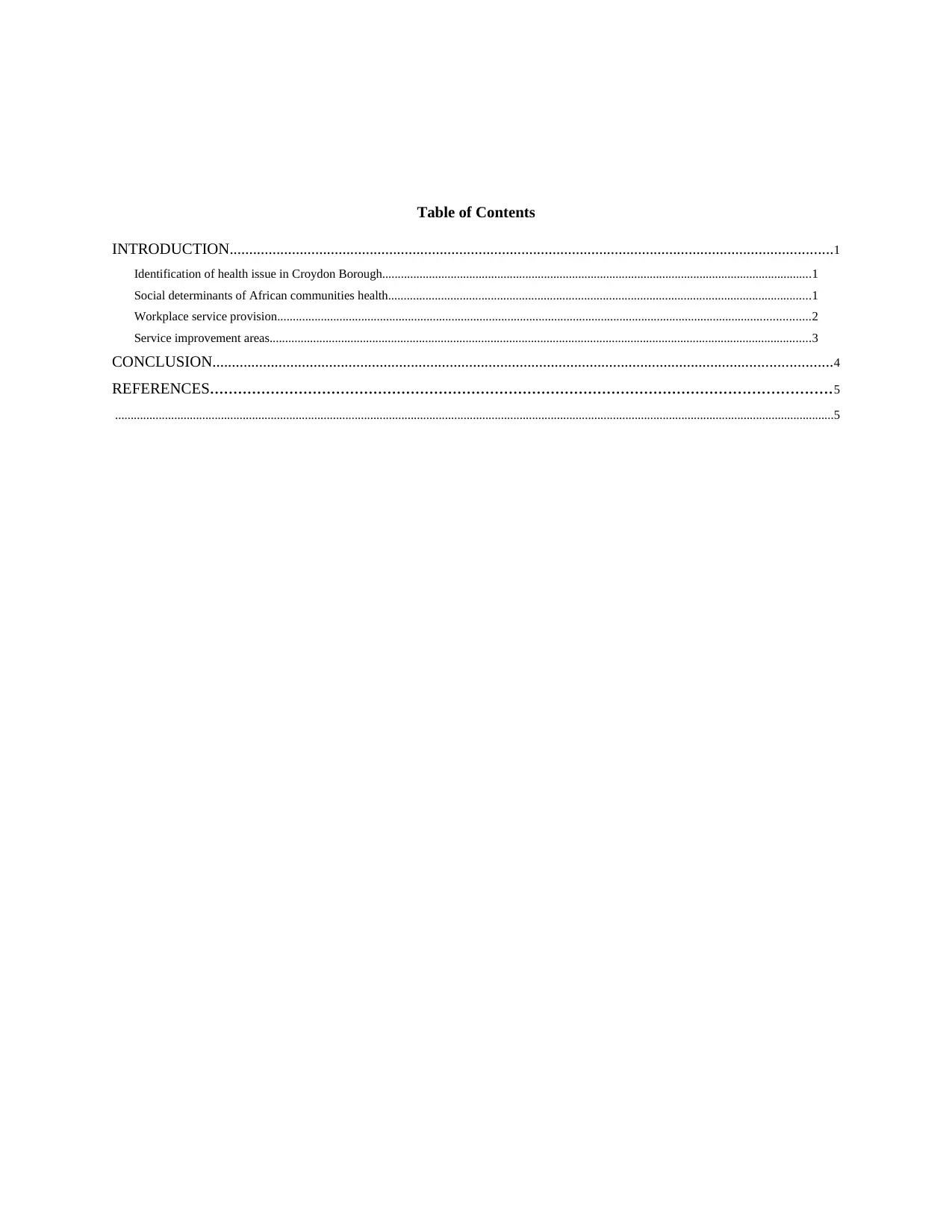
Table of Contents
INTRODUCTION...........................................................................................................................................................1
Identification of health issue in Croydon Borough..........................................................................................................................................1
Social determinants of African communities health........................................................................................................................................1
Workplace service provision...........................................................................................................................................................................2
Service improvement areas..............................................................................................................................................................................3
CONCLUSION...............................................................................................................................................................4
REFERENCES.....................................................................................................................................5
.......................................................................................................................................................................................................................................5
INTRODUCTION...........................................................................................................................................................1
Identification of health issue in Croydon Borough..........................................................................................................................................1
Social determinants of African communities health........................................................................................................................................1
Workplace service provision...........................................................................................................................................................................2
Service improvement areas..............................................................................................................................................................................3
CONCLUSION...............................................................................................................................................................4
REFERENCES.....................................................................................................................................5
.......................................................................................................................................................................................................................................5
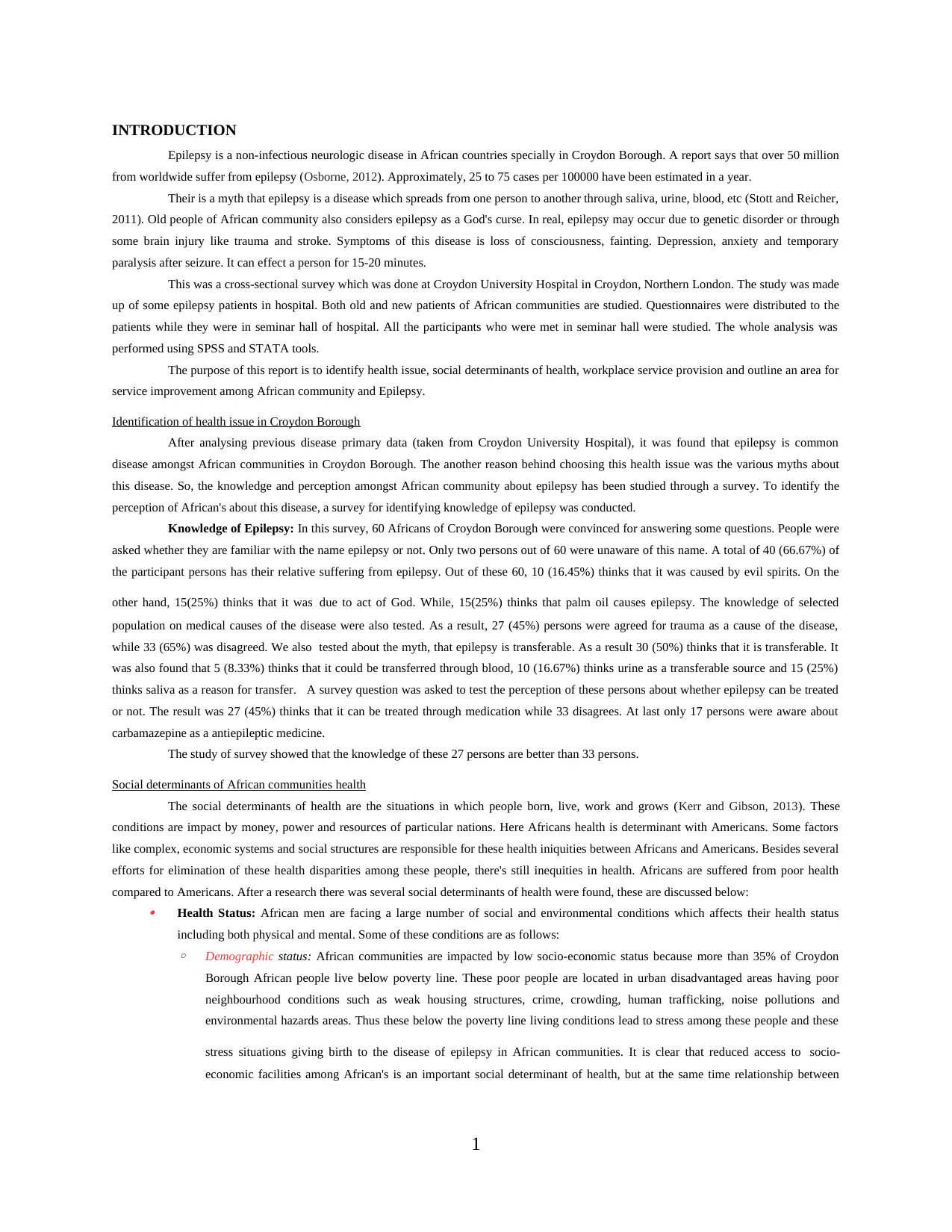
INTRODUCTION
Epilepsy is a non-infectious neurologic disease in African countries specially in Croydon Borough. A report says that over 50 million
from worldwide suffer from epilepsy (Osborne, 2012). Approximately, 25 to 75 cases per 100000 have been estimated in a year.
Their is a myth that epilepsy is a disease which spreads from one person to another through saliva, urine, blood, etc (Stott and Reicher,
2011). Old people of African community also considers epilepsy as a God's curse. In real, epilepsy may occur due to genetic disorder or through
some brain injury like trauma and stroke. Symptoms of this disease is loss of consciousness, fainting. Depression, anxiety and temporary
paralysis after seizure. It can effect a person for 15-20 minutes.
This was a cross-sectional survey which was done at Croydon University Hospital in Croydon, Northern London. The study was made
up of some epilepsy patients in hospital. Both old and new patients of African communities are studied. Questionnaires were distributed to the
patients while they were in seminar hall of hospital. All the participants who were met in seminar hall were studied. The whole analysis was
performed using SPSS and STATA tools.
The purpose of this report is to identify health issue, social determinants of health, workplace service provision and outline an area for
service improvement among African community and Epilepsy.
Identification of health issue in Croydon Borough
After analysing previous disease primary data (taken from Croydon University Hospital), it was found that epilepsy is common
disease amongst African communities in Croydon Borough. The another reason behind choosing this health issue was the various myths about
this disease. So, the knowledge and perception amongst African community about epilepsy has been studied through a survey. To identify the
perception of African's about this disease, a survey for identifying knowledge of epilepsy was conducted.
Knowledge of Epilepsy: In this survey, 60 Africans of Croydon Borough were convinced for answering some questions. People were
asked whether they are familiar with the name epilepsy or not. Only two persons out of 60 were unaware of this name. A total of 40 (66.67%) of
the participant persons has their relative suffering from epilepsy. Out of these 60, 10 (16.45%) thinks that it was caused by evil spirits. On the
other hand, 15(25%) thinks that it was due to act of God. While, 15(25%) thinks that palm oil causes epilepsy. The knowledge of selected
population on medical causes of the disease were also tested. As a result, 27 (45%) persons were agreed for trauma as a cause of the disease,
while 33 (65%) was disagreed. We also tested about the myth, that epilepsy is transferable. As a result 30 (50%) thinks that it is transferable. It
was also found that 5 (8.33%) thinks that it could be transferred through blood, 10 (16.67%) thinks urine as a transferable source and 15 (25%)
thinks saliva as a reason for transfer. A survey question was asked to test the perception of these persons about whether epilepsy can be treated
or not. The result was 27 (45%) thinks that it can be treated through medication while 33 disagrees. At last only 17 persons were aware about
carbamazepine as a antiepileptic medicine.
The study of survey showed that the knowledge of these 27 persons are better than 33 persons.
Social determinants of African communities health
The social determinants of health are the situations in which people born, live, work and grows (Kerr and Gibson, 2013). These
conditions are impact by money, power and resources of particular nations. Here Africans health is determinant with Americans. Some factors
like complex, economic systems and social structures are responsible for these health iniquities between Africans and Americans. Besides several
efforts for elimination of these health disparities among these people, there's still inequities in health. Africans are suffered from poor health
compared to Americans. After a research there was several social determinants of health were found, these are discussed below:
Health Status: African men are facing a large number of social and environmental conditions which affects their health status
including both physical and mental. Some of these conditions are as follows:
◦ Demographic status: African communities are impacted by low socio-economic status because more than 35% of Croydon
Borough African people live below poverty line. These poor people are located in urban disadvantaged areas having poor
neighbourhood conditions such as weak housing structures, crime, crowding, human trafficking, noise pollutions and
environmental hazards areas. Thus these below the poverty line living conditions lead to stress among these people and these
stress situations giving birth to the disease of epilepsy in African communities. It is clear that reduced access to socio-
economic facilities among African's is an important social determinant of health, but at the same time relationship between
1
Epilepsy is a non-infectious neurologic disease in African countries specially in Croydon Borough. A report says that over 50 million
from worldwide suffer from epilepsy (Osborne, 2012). Approximately, 25 to 75 cases per 100000 have been estimated in a year.
Their is a myth that epilepsy is a disease which spreads from one person to another through saliva, urine, blood, etc (Stott and Reicher,
2011). Old people of African community also considers epilepsy as a God's curse. In real, epilepsy may occur due to genetic disorder or through
some brain injury like trauma and stroke. Symptoms of this disease is loss of consciousness, fainting. Depression, anxiety and temporary
paralysis after seizure. It can effect a person for 15-20 minutes.
This was a cross-sectional survey which was done at Croydon University Hospital in Croydon, Northern London. The study was made
up of some epilepsy patients in hospital. Both old and new patients of African communities are studied. Questionnaires were distributed to the
patients while they were in seminar hall of hospital. All the participants who were met in seminar hall were studied. The whole analysis was
performed using SPSS and STATA tools.
The purpose of this report is to identify health issue, social determinants of health, workplace service provision and outline an area for
service improvement among African community and Epilepsy.
Identification of health issue in Croydon Borough
After analysing previous disease primary data (taken from Croydon University Hospital), it was found that epilepsy is common
disease amongst African communities in Croydon Borough. The another reason behind choosing this health issue was the various myths about
this disease. So, the knowledge and perception amongst African community about epilepsy has been studied through a survey. To identify the
perception of African's about this disease, a survey for identifying knowledge of epilepsy was conducted.
Knowledge of Epilepsy: In this survey, 60 Africans of Croydon Borough were convinced for answering some questions. People were
asked whether they are familiar with the name epilepsy or not. Only two persons out of 60 were unaware of this name. A total of 40 (66.67%) of
the participant persons has their relative suffering from epilepsy. Out of these 60, 10 (16.45%) thinks that it was caused by evil spirits. On the
other hand, 15(25%) thinks that it was due to act of God. While, 15(25%) thinks that palm oil causes epilepsy. The knowledge of selected
population on medical causes of the disease were also tested. As a result, 27 (45%) persons were agreed for trauma as a cause of the disease,
while 33 (65%) was disagreed. We also tested about the myth, that epilepsy is transferable. As a result 30 (50%) thinks that it is transferable. It
was also found that 5 (8.33%) thinks that it could be transferred through blood, 10 (16.67%) thinks urine as a transferable source and 15 (25%)
thinks saliva as a reason for transfer. A survey question was asked to test the perception of these persons about whether epilepsy can be treated
or not. The result was 27 (45%) thinks that it can be treated through medication while 33 disagrees. At last only 17 persons were aware about
carbamazepine as a antiepileptic medicine.
The study of survey showed that the knowledge of these 27 persons are better than 33 persons.
Social determinants of African communities health
The social determinants of health are the situations in which people born, live, work and grows (Kerr and Gibson, 2013). These
conditions are impact by money, power and resources of particular nations. Here Africans health is determinant with Americans. Some factors
like complex, economic systems and social structures are responsible for these health iniquities between Africans and Americans. Besides several
efforts for elimination of these health disparities among these people, there's still inequities in health. Africans are suffered from poor health
compared to Americans. After a research there was several social determinants of health were found, these are discussed below:
Health Status: African men are facing a large number of social and environmental conditions which affects their health status
including both physical and mental. Some of these conditions are as follows:
◦ Demographic status: African communities are impacted by low socio-economic status because more than 35% of Croydon
Borough African people live below poverty line. These poor people are located in urban disadvantaged areas having poor
neighbourhood conditions such as weak housing structures, crime, crowding, human trafficking, noise pollutions and
environmental hazards areas. Thus these below the poverty line living conditions lead to stress among these people and these
stress situations giving birth to the disease of epilepsy in African communities. It is clear that reduced access to socio-
economic facilities among African's is an important social determinant of health, but at the same time relationship between
1
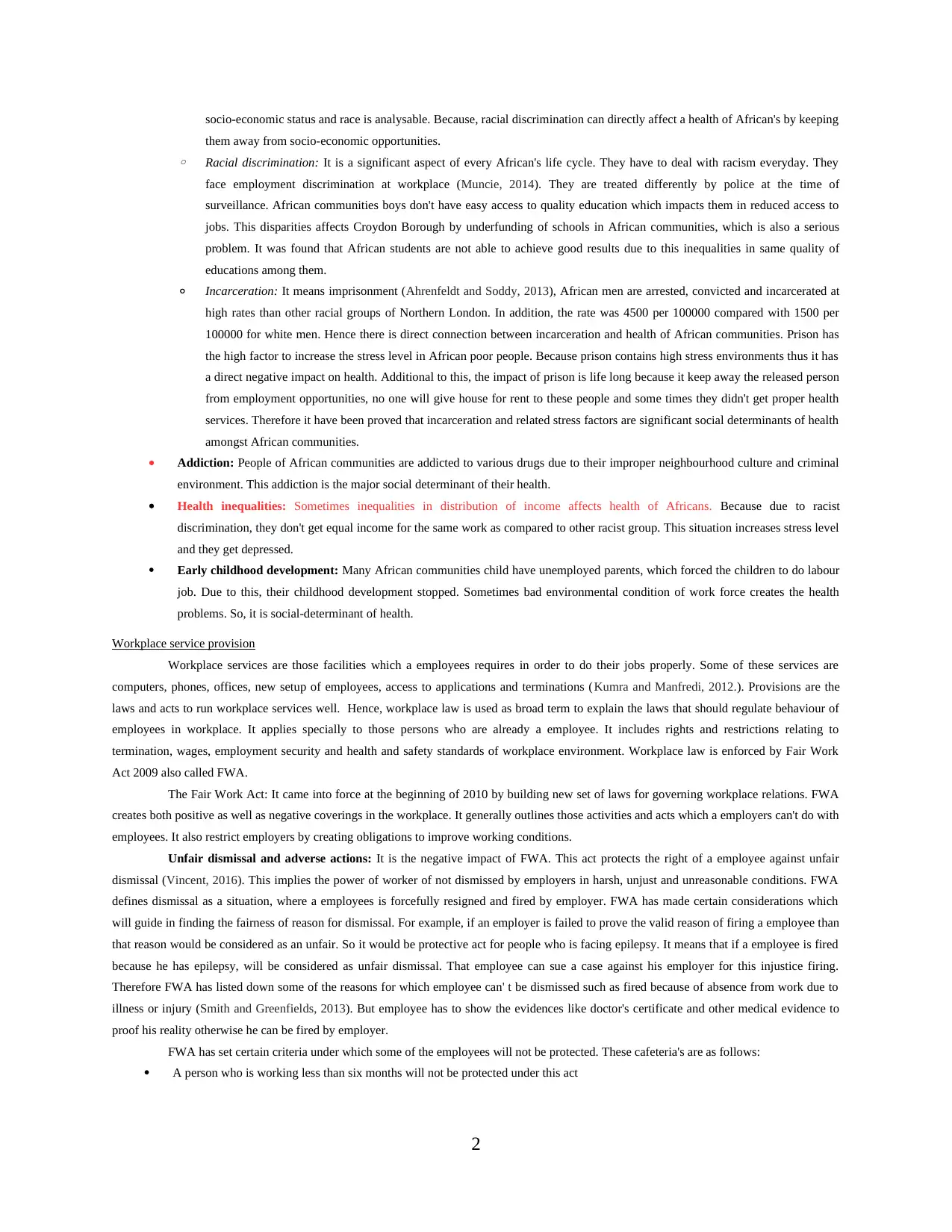
socio-economic status and race is analysable. Because, racial discrimination can directly affect a health of African's by keeping
them away from socio-economic opportunities.
◦ Racial discrimination: It is a significant aspect of every African's life cycle. They have to deal with racism everyday. They
face employment discrimination at workplace (Muncie, 2014). They are treated differently by police at the time of
surveillance. African communities boys don't have easy access to quality education which impacts them in reduced access to
jobs. This disparities affects Croydon Borough by underfunding of schools in African communities, which is also a serious
problem. It was found that African students are not able to achieve good results due to this inequalities in same quality of
educations among them.
◦ Incarceration: It means imprisonment (Ahrenfeldt and Soddy, 2013), African men are arrested, convicted and incarcerated at
high rates than other racial groups of Northern London. In addition, the rate was 4500 per 100000 compared with 1500 per
100000 for white men. Hence there is direct connection between incarceration and health of African communities. Prison has
the high factor to increase the stress level in African poor people. Because prison contains high stress environments thus it has
a direct negative impact on health. Additional to this, the impact of prison is life long because it keep away the released person
from employment opportunities, no one will give house for rent to these people and some times they didn't get proper health
services. Therefore it have been proved that incarceration and related stress factors are significant social determinants of health
amongst African communities.
Addiction: People of African communities are addicted to various drugs due to their improper neighbourhood culture and criminal
environment. This addiction is the major social determinant of their health.
Health inequalities: Sometimes inequalities in distribution of income affects health of Africans. Because due to racist
discrimination, they don't get equal income for the same work as compared to other racist group. This situation increases stress level
and they get depressed.
Early childhood development: Many African communities child have unemployed parents, which forced the children to do labour
job. Due to this, their childhood development stopped. Sometimes bad environmental condition of work force creates the health
problems. So, it is social-determinant of health.
Workplace service provision
Workplace services are those facilities which a employees requires in order to do their jobs properly. Some of these services are
computers, phones, offices, new setup of employees, access to applications and terminations (Kumra and Manfredi, 2012.). Provisions are the
laws and acts to run workplace services well. Hence, workplace law is used as broad term to explain the laws that should regulate behaviour of
employees in workplace. It applies specially to those persons who are already a employee. It includes rights and restrictions relating to
termination, wages, employment security and health and safety standards of workplace environment. Workplace law is enforced by Fair Work
Act 2009 also called FWA.
The Fair Work Act: It came into force at the beginning of 2010 by building new set of laws for governing workplace relations. FWA
creates both positive as well as negative coverings in the workplace. It generally outlines those activities and acts which a employers can't do with
employees. It also restrict employers by creating obligations to improve working conditions.
Unfair dismissal and adverse actions: It is the negative impact of FWA. This act protects the right of a employee against unfair
dismissal (Vincent, 2016). This implies the power of worker of not dismissed by employers in harsh, unjust and unreasonable conditions. FWA
defines dismissal as a situation, where a employees is forcefully resigned and fired by employer. FWA has made certain considerations which
will guide in finding the fairness of reason for dismissal. For example, if an employer is failed to prove the valid reason of firing a employee than
that reason would be considered as an unfair. So it would be protective act for people who is facing epilepsy. It means that if a employee is fired
because he has epilepsy, will be considered as unfair dismissal. That employee can sue a case against his employer for this injustice firing.
Therefore FWA has listed down some of the reasons for which employee can' t be dismissed such as fired because of absence from work due to
illness or injury (Smith and Greenfields, 2013). But employee has to show the evidences like doctor's certificate and other medical evidence to
proof his reality otherwise he can be fired by employer.
FWA has set certain criteria under which some of the employees will not be protected. These cafeteria's are as follows:
A person who is working less than six months will not be protected under this act
2
them away from socio-economic opportunities.
◦ Racial discrimination: It is a significant aspect of every African's life cycle. They have to deal with racism everyday. They
face employment discrimination at workplace (Muncie, 2014). They are treated differently by police at the time of
surveillance. African communities boys don't have easy access to quality education which impacts them in reduced access to
jobs. This disparities affects Croydon Borough by underfunding of schools in African communities, which is also a serious
problem. It was found that African students are not able to achieve good results due to this inequalities in same quality of
educations among them.
◦ Incarceration: It means imprisonment (Ahrenfeldt and Soddy, 2013), African men are arrested, convicted and incarcerated at
high rates than other racial groups of Northern London. In addition, the rate was 4500 per 100000 compared with 1500 per
100000 for white men. Hence there is direct connection between incarceration and health of African communities. Prison has
the high factor to increase the stress level in African poor people. Because prison contains high stress environments thus it has
a direct negative impact on health. Additional to this, the impact of prison is life long because it keep away the released person
from employment opportunities, no one will give house for rent to these people and some times they didn't get proper health
services. Therefore it have been proved that incarceration and related stress factors are significant social determinants of health
amongst African communities.
Addiction: People of African communities are addicted to various drugs due to their improper neighbourhood culture and criminal
environment. This addiction is the major social determinant of their health.
Health inequalities: Sometimes inequalities in distribution of income affects health of Africans. Because due to racist
discrimination, they don't get equal income for the same work as compared to other racist group. This situation increases stress level
and they get depressed.
Early childhood development: Many African communities child have unemployed parents, which forced the children to do labour
job. Due to this, their childhood development stopped. Sometimes bad environmental condition of work force creates the health
problems. So, it is social-determinant of health.
Workplace service provision
Workplace services are those facilities which a employees requires in order to do their jobs properly. Some of these services are
computers, phones, offices, new setup of employees, access to applications and terminations (Kumra and Manfredi, 2012.). Provisions are the
laws and acts to run workplace services well. Hence, workplace law is used as broad term to explain the laws that should regulate behaviour of
employees in workplace. It applies specially to those persons who are already a employee. It includes rights and restrictions relating to
termination, wages, employment security and health and safety standards of workplace environment. Workplace law is enforced by Fair Work
Act 2009 also called FWA.
The Fair Work Act: It came into force at the beginning of 2010 by building new set of laws for governing workplace relations. FWA
creates both positive as well as negative coverings in the workplace. It generally outlines those activities and acts which a employers can't do with
employees. It also restrict employers by creating obligations to improve working conditions.
Unfair dismissal and adverse actions: It is the negative impact of FWA. This act protects the right of a employee against unfair
dismissal (Vincent, 2016). This implies the power of worker of not dismissed by employers in harsh, unjust and unreasonable conditions. FWA
defines dismissal as a situation, where a employees is forcefully resigned and fired by employer. FWA has made certain considerations which
will guide in finding the fairness of reason for dismissal. For example, if an employer is failed to prove the valid reason of firing a employee than
that reason would be considered as an unfair. So it would be protective act for people who is facing epilepsy. It means that if a employee is fired
because he has epilepsy, will be considered as unfair dismissal. That employee can sue a case against his employer for this injustice firing.
Therefore FWA has listed down some of the reasons for which employee can' t be dismissed such as fired because of absence from work due to
illness or injury (Smith and Greenfields, 2013). But employee has to show the evidences like doctor's certificate and other medical evidence to
proof his reality otherwise he can be fired by employer.
FWA has set certain criteria under which some of the employees will not be protected. These cafeteria's are as follows:
A person who is working less than six months will not be protected under this act
2
Secure Best Marks with AI Grader
Need help grading? Try our AI Grader for instant feedback on your assignments.
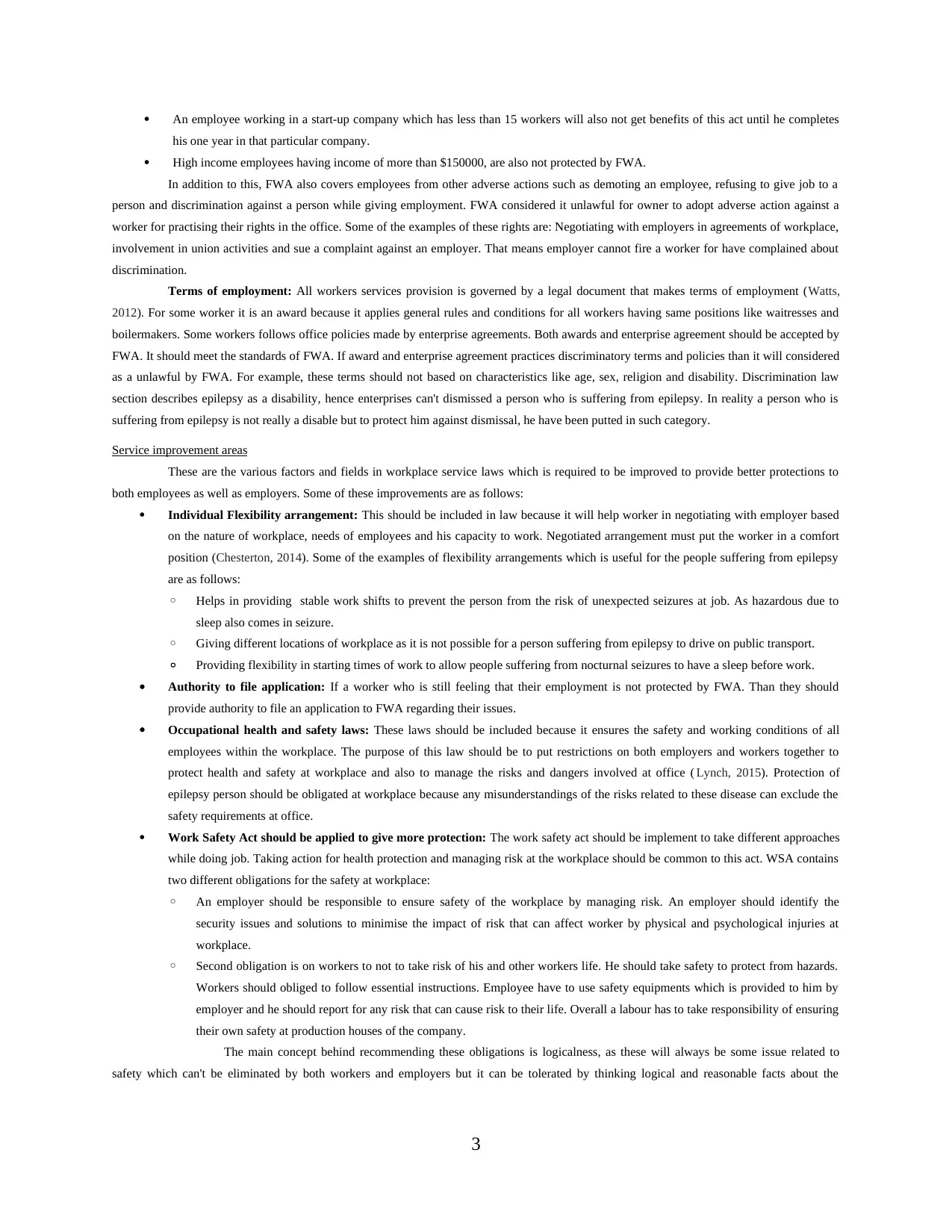
An employee working in a start-up company which has less than 15 workers will also not get benefits of this act until he completes
his one year in that particular company.
High income employees having income of more than $150000, are also not protected by FWA.
In addition to this, FWA also covers employees from other adverse actions such as demoting an employee, refusing to give job to a
person and discrimination against a person while giving employment. FWA considered it unlawful for owner to adopt adverse action against a
worker for practising their rights in the office. Some of the examples of these rights are: Negotiating with employers in agreements of workplace,
involvement in union activities and sue a complaint against an employer. That means employer cannot fire a worker for have complained about
discrimination.
Terms of employment: All workers services provision is governed by a legal document that makes terms of employment (Watts,
2012). For some worker it is an award because it applies general rules and conditions for all workers having same positions like waitresses and
boilermakers. Some workers follows office policies made by enterprise agreements. Both awards and enterprise agreement should be accepted by
FWA. It should meet the standards of FWA. If award and enterprise agreement practices discriminatory terms and policies than it will considered
as a unlawful by FWA. For example, these terms should not based on characteristics like age, sex, religion and disability. Discrimination law
section describes epilepsy as a disability, hence enterprises can't dismissed a person who is suffering from epilepsy. In reality a person who is
suffering from epilepsy is not really a disable but to protect him against dismissal, he have been putted in such category.
Service improvement areas
These are the various factors and fields in workplace service laws which is required to be improved to provide better protections to
both employees as well as employers. Some of these improvements are as follows:
Individual Flexibility arrangement: This should be included in law because it will help worker in negotiating with employer based
on the nature of workplace, needs of employees and his capacity to work. Negotiated arrangement must put the worker in a comfort
position (Chesterton, 2014). Some of the examples of flexibility arrangements which is useful for the people suffering from epilepsy
are as follows:
◦ Helps in providing stable work shifts to prevent the person from the risk of unexpected seizures at job. As hazardous due to
sleep also comes in seizure.
◦ Giving different locations of workplace as it is not possible for a person suffering from epilepsy to drive on public transport.
◦ Providing flexibility in starting times of work to allow people suffering from nocturnal seizures to have a sleep before work.
Authority to file application: If a worker who is still feeling that their employment is not protected by FWA. Than they should
provide authority to file an application to FWA regarding their issues.
Occupational health and safety laws: These laws should be included because it ensures the safety and working conditions of all
employees within the workplace. The purpose of this law should be to put restrictions on both employers and workers together to
protect health and safety at workplace and also to manage the risks and dangers involved at office ( Lynch, 2015). Protection of
epilepsy person should be obligated at workplace because any misunderstandings of the risks related to these disease can exclude the
safety requirements at office.
Work Safety Act should be applied to give more protection: The work safety act should be implement to take different approaches
while doing job. Taking action for health protection and managing risk at the workplace should be common to this act. WSA contains
two different obligations for the safety at workplace:
◦ An employer should be responsible to ensure safety of the workplace by managing risk. An employer should identify the
security issues and solutions to minimise the impact of risk that can affect worker by physical and psychological injuries at
workplace.
◦ Second obligation is on workers to not to take risk of his and other workers life. He should take safety to protect from hazards.
Workers should obliged to follow essential instructions. Employee have to use safety equipments which is provided to him by
employer and he should report for any risk that can cause risk to their life. Overall a labour has to take responsibility of ensuring
their own safety at production houses of the company.
The main concept behind recommending these obligations is logicalness, as these will always be some issue related to
safety which can't be eliminated by both workers and employers but it can be tolerated by thinking logical and reasonable facts about the
3
his one year in that particular company.
High income employees having income of more than $150000, are also not protected by FWA.
In addition to this, FWA also covers employees from other adverse actions such as demoting an employee, refusing to give job to a
person and discrimination against a person while giving employment. FWA considered it unlawful for owner to adopt adverse action against a
worker for practising their rights in the office. Some of the examples of these rights are: Negotiating with employers in agreements of workplace,
involvement in union activities and sue a complaint against an employer. That means employer cannot fire a worker for have complained about
discrimination.
Terms of employment: All workers services provision is governed by a legal document that makes terms of employment (Watts,
2012). For some worker it is an award because it applies general rules and conditions for all workers having same positions like waitresses and
boilermakers. Some workers follows office policies made by enterprise agreements. Both awards and enterprise agreement should be accepted by
FWA. It should meet the standards of FWA. If award and enterprise agreement practices discriminatory terms and policies than it will considered
as a unlawful by FWA. For example, these terms should not based on characteristics like age, sex, religion and disability. Discrimination law
section describes epilepsy as a disability, hence enterprises can't dismissed a person who is suffering from epilepsy. In reality a person who is
suffering from epilepsy is not really a disable but to protect him against dismissal, he have been putted in such category.
Service improvement areas
These are the various factors and fields in workplace service laws which is required to be improved to provide better protections to
both employees as well as employers. Some of these improvements are as follows:
Individual Flexibility arrangement: This should be included in law because it will help worker in negotiating with employer based
on the nature of workplace, needs of employees and his capacity to work. Negotiated arrangement must put the worker in a comfort
position (Chesterton, 2014). Some of the examples of flexibility arrangements which is useful for the people suffering from epilepsy
are as follows:
◦ Helps in providing stable work shifts to prevent the person from the risk of unexpected seizures at job. As hazardous due to
sleep also comes in seizure.
◦ Giving different locations of workplace as it is not possible for a person suffering from epilepsy to drive on public transport.
◦ Providing flexibility in starting times of work to allow people suffering from nocturnal seizures to have a sleep before work.
Authority to file application: If a worker who is still feeling that their employment is not protected by FWA. Than they should
provide authority to file an application to FWA regarding their issues.
Occupational health and safety laws: These laws should be included because it ensures the safety and working conditions of all
employees within the workplace. The purpose of this law should be to put restrictions on both employers and workers together to
protect health and safety at workplace and also to manage the risks and dangers involved at office ( Lynch, 2015). Protection of
epilepsy person should be obligated at workplace because any misunderstandings of the risks related to these disease can exclude the
safety requirements at office.
Work Safety Act should be applied to give more protection: The work safety act should be implement to take different approaches
while doing job. Taking action for health protection and managing risk at the workplace should be common to this act. WSA contains
two different obligations for the safety at workplace:
◦ An employer should be responsible to ensure safety of the workplace by managing risk. An employer should identify the
security issues and solutions to minimise the impact of risk that can affect worker by physical and psychological injuries at
workplace.
◦ Second obligation is on workers to not to take risk of his and other workers life. He should take safety to protect from hazards.
Workers should obliged to follow essential instructions. Employee have to use safety equipments which is provided to him by
employer and he should report for any risk that can cause risk to their life. Overall a labour has to take responsibility of ensuring
their own safety at production houses of the company.
The main concept behind recommending these obligations is logicalness, as these will always be some issue related to
safety which can't be eliminated by both workers and employers but it can be tolerated by thinking logical and reasonable facts about the
3
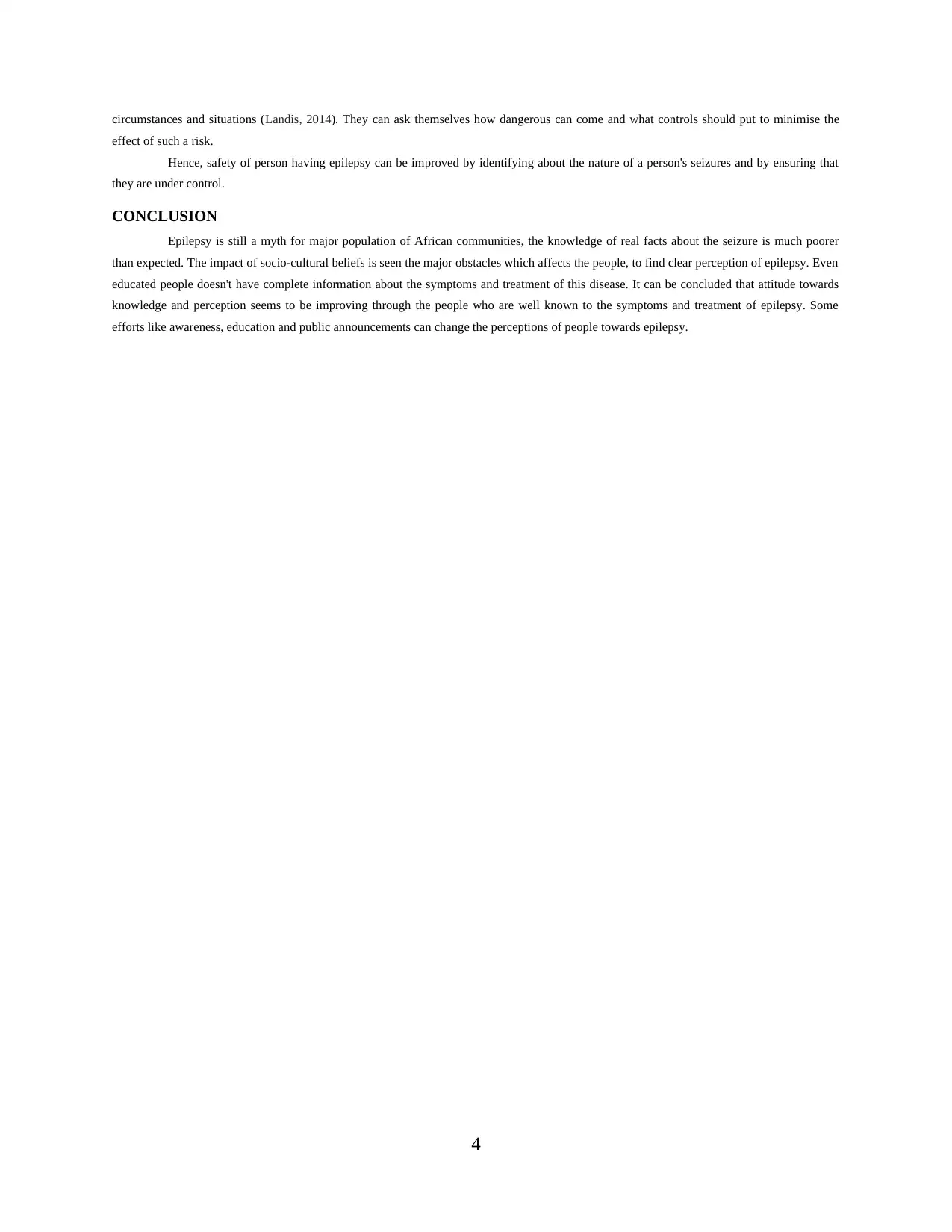
circumstances and situations (Landis, 2014). They can ask themselves how dangerous can come and what controls should put to minimise the
effect of such a risk.
Hence, safety of person having epilepsy can be improved by identifying about the nature of a person's seizures and by ensuring that
they are under control.
CONCLUSION
Epilepsy is still a myth for major population of African communities, the knowledge of real facts about the seizure is much poorer
than expected. The impact of socio-cultural beliefs is seen the major obstacles which affects the people, to find clear perception of epilepsy. Even
educated people doesn't have complete information about the symptoms and treatment of this disease. It can be concluded that attitude towards
knowledge and perception seems to be improving through the people who are well known to the symptoms and treatment of epilepsy. Some
efforts like awareness, education and public announcements can change the perceptions of people towards epilepsy.
4
effect of such a risk.
Hence, safety of person having epilepsy can be improved by identifying about the nature of a person's seizures and by ensuring that
they are under control.
CONCLUSION
Epilepsy is still a myth for major population of African communities, the knowledge of real facts about the seizure is much poorer
than expected. The impact of socio-cultural beliefs is seen the major obstacles which affects the people, to find clear perception of epilepsy. Even
educated people doesn't have complete information about the symptoms and treatment of this disease. It can be concluded that attitude towards
knowledge and perception seems to be improving through the people who are well known to the symptoms and treatment of epilepsy. Some
efforts like awareness, education and public announcements can change the perceptions of people towards epilepsy.
4
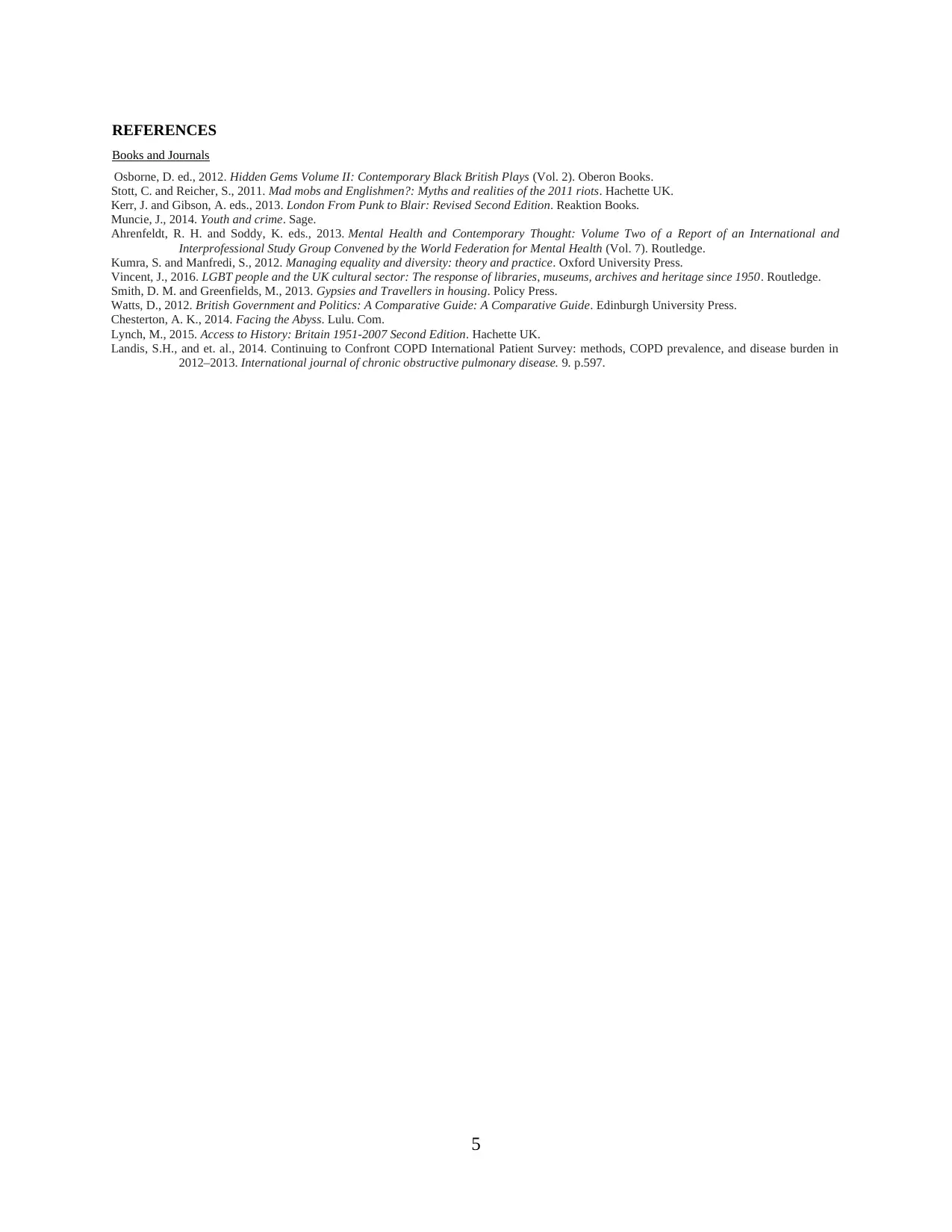
REFERENCES
Books and Journals
Osborne, D. ed., 2012. Hidden Gems Volume II: Contemporary Black British Plays (Vol. 2). Oberon Books.
Stott, C. and Reicher, S., 2011. Mad mobs and Englishmen?: Myths and realities of the 2011 riots. Hachette UK.
Kerr, J. and Gibson, A. eds., 2013. London From Punk to Blair: Revised Second Edition. Reaktion Books.
Muncie, J., 2014. Youth and crime. Sage.
Ahrenfeldt, R. H. and Soddy, K. eds., 2013. Mental Health and Contemporary Thought: Volume Two of a Report of an International and
Interprofessional Study Group Convened by the World Federation for Mental Health (Vol. 7). Routledge.
Kumra, S. and Manfredi, S., 2012. Managing equality and diversity: theory and practice. Oxford University Press.
Vincent, J., 2016. LGBT people and the UK cultural sector: The response of libraries, museums, archives and heritage since 1950. Routledge.
Smith, D. M. and Greenfields, M., 2013. Gypsies and Travellers in housing. Policy Press.
Watts, D., 2012. British Government and Politics: A Comparative Guide: A Comparative Guide. Edinburgh University Press.
Chesterton, A. K., 2014. Facing the Abyss. Lulu. Com.
Lynch, M., 2015. Access to History: Britain 1951-2007 Second Edition. Hachette UK.
Landis, S.H., and et. al., 2014. Continuing to Confront COPD International Patient Survey: methods, COPD prevalence, and disease burden in
2012–2013. International journal of chronic obstructive pulmonary disease. 9. p.597.
5
Books and Journals
Osborne, D. ed., 2012. Hidden Gems Volume II: Contemporary Black British Plays (Vol. 2). Oberon Books.
Stott, C. and Reicher, S., 2011. Mad mobs and Englishmen?: Myths and realities of the 2011 riots. Hachette UK.
Kerr, J. and Gibson, A. eds., 2013. London From Punk to Blair: Revised Second Edition. Reaktion Books.
Muncie, J., 2014. Youth and crime. Sage.
Ahrenfeldt, R. H. and Soddy, K. eds., 2013. Mental Health and Contemporary Thought: Volume Two of a Report of an International and
Interprofessional Study Group Convened by the World Federation for Mental Health (Vol. 7). Routledge.
Kumra, S. and Manfredi, S., 2012. Managing equality and diversity: theory and practice. Oxford University Press.
Vincent, J., 2016. LGBT people and the UK cultural sector: The response of libraries, museums, archives and heritage since 1950. Routledge.
Smith, D. M. and Greenfields, M., 2013. Gypsies and Travellers in housing. Policy Press.
Watts, D., 2012. British Government and Politics: A Comparative Guide: A Comparative Guide. Edinburgh University Press.
Chesterton, A. K., 2014. Facing the Abyss. Lulu. Com.
Lynch, M., 2015. Access to History: Britain 1951-2007 Second Edition. Hachette UK.
Landis, S.H., and et. al., 2014. Continuing to Confront COPD International Patient Survey: methods, COPD prevalence, and disease burden in
2012–2013. International journal of chronic obstructive pulmonary disease. 9. p.597.
5
1 out of 7
Your All-in-One AI-Powered Toolkit for Academic Success.
+13062052269
info@desklib.com
Available 24*7 on WhatsApp / Email
![[object Object]](/_next/static/media/star-bottom.7253800d.svg)
Unlock your academic potential
© 2024 | Zucol Services PVT LTD | All rights reserved.
